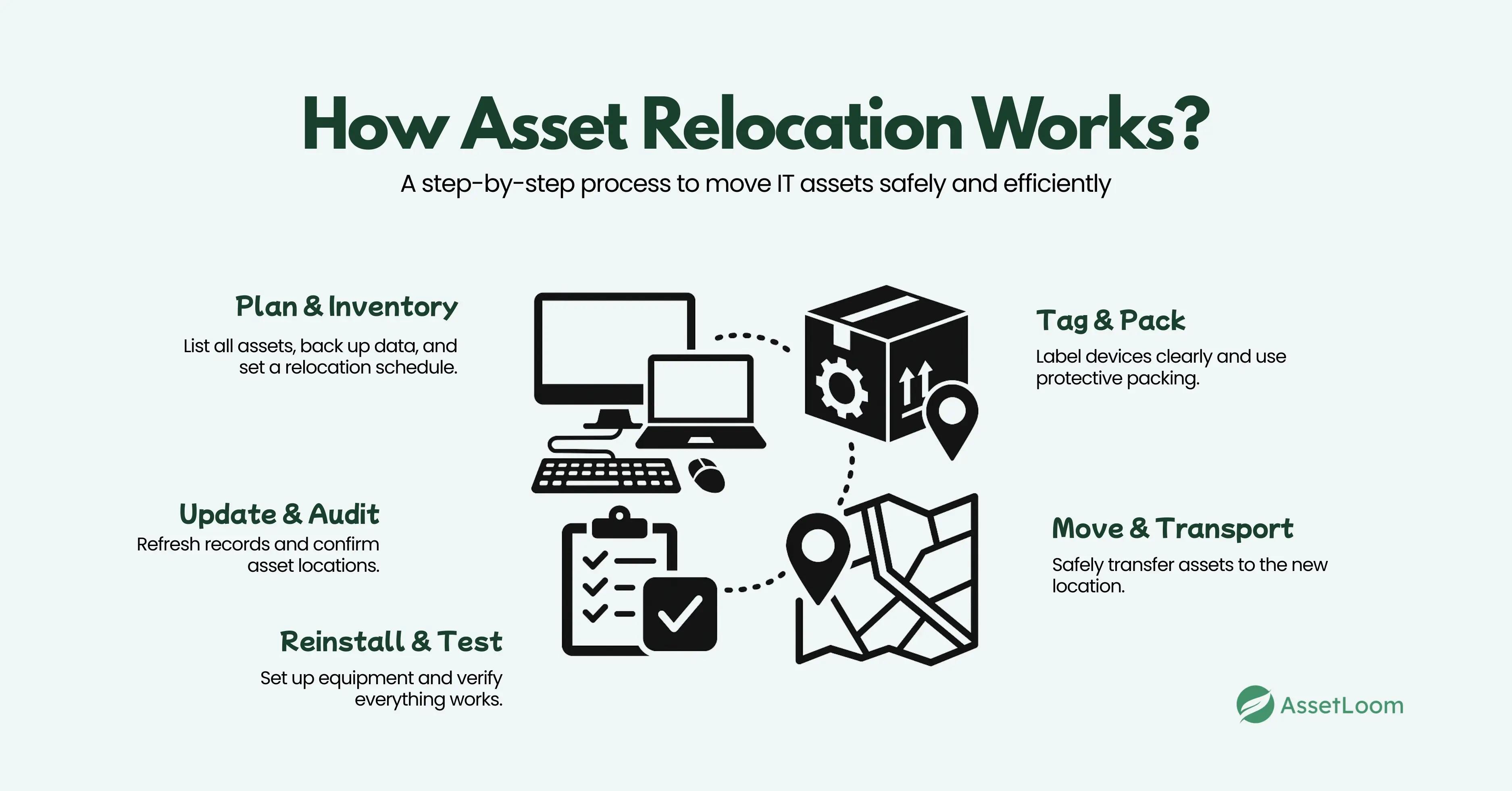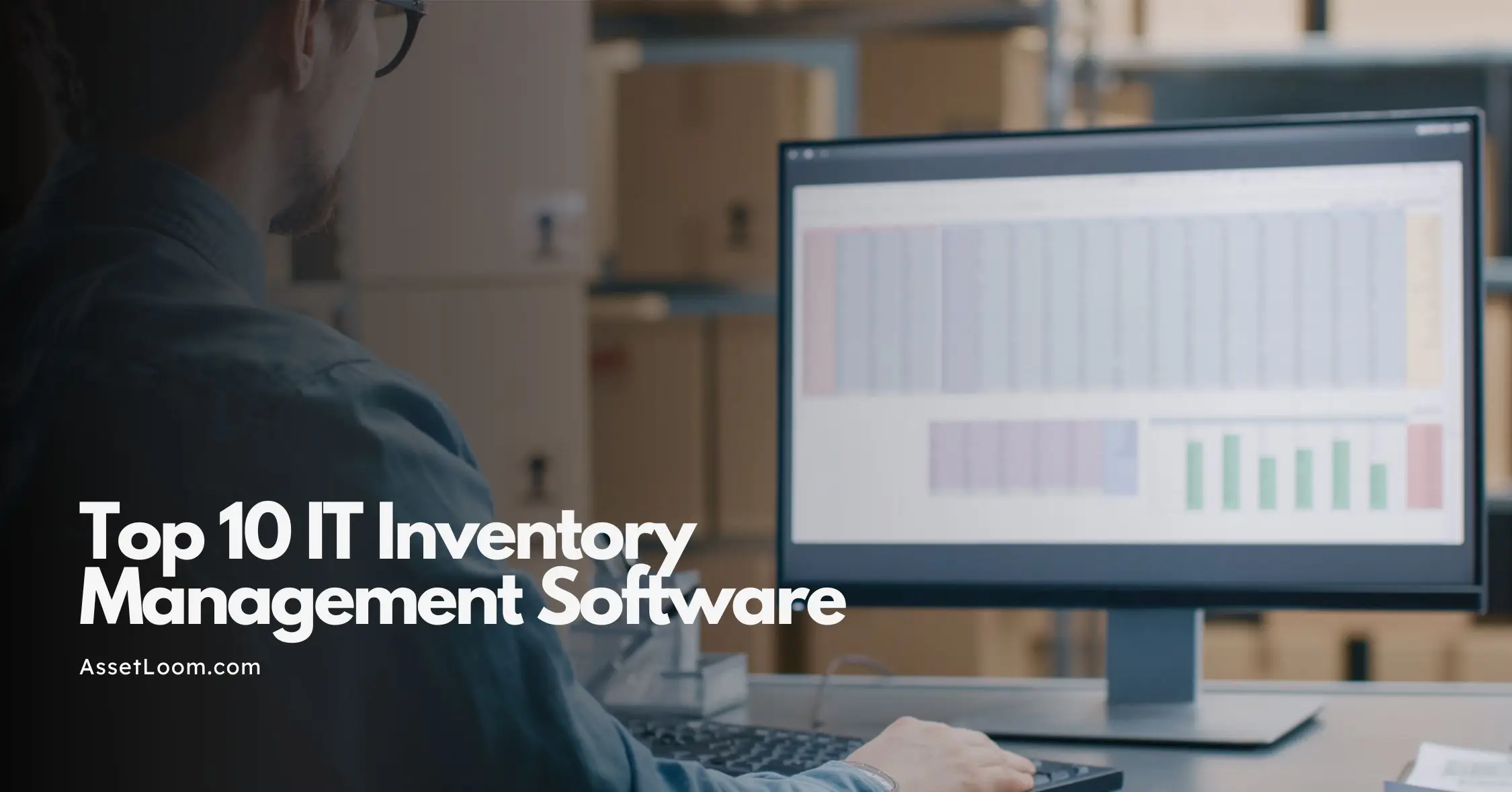What is Asset Relocation, and How Does It Work?
Asset relocation is the organized process of moving IT assets with proper planning, tracking, and testing to ensure a smooth, secure, and efficient transition.
When you're moving to a new office, shifting departments, or upgrading your setup, you’re probably dealing with a mess of cables, missing items, outdated spreadsheets, and a whole lot of questions.
Asset relocation is the process that helps bring order to that chaos. It’s all about moving your IT equipment, like laptops, monitors, servers, and peripherals, from one place to another in a way that’s organized, secure, and efficient. But it’s more than just moving boxes. It involves planning, tracking, tagging, transporting, reinstalling, and updating records so that nothing gets lost and everything ends up exactly where it needs to be.
When done properly, asset relocation saves time, reduces downtime, and keeps your IT inventory accurate and up to date. And with the right tools, like AssetLoom, it becomes much easier to manage.
What is Asset Relocation?
Asset relocation is the organized process of moving IT assets such as laptops, desktops, servers, monitors, phones, and even software licenses from one physical location to another.
It’s more than just packing and shipping. Proper asset relocation involves carefully tracking every item, keeping records up to date, and making sure all equipment is fully functional and accounted for after the move.
Types of IT Assets Involved in Relocation
Asset relocation often includes a wide range of IT equipment. This can be anything from laptops, desktops, servers, and monitors, to smaller items like keyboards, mice, and headsets. Network devices such as routers and switches are also common, along with mobile devices like tablets and smartphones. In many cases, software and license assignments tied to specific hardware are also part of the relocation process. Moving these assets isn't just about transporting the hardware. It's about making sure everything is documented, assigned correctly, and ready to use once it reaches its destination.
Common Scenarios for Asset Relocation
There are several situations where an organized asset relocation process is essential. Some of the most common include:
- Office Moves: Setting up a new location or moving departments within the same building.
- Team Restructuring: Reassigning equipment when teams grow, merge, or shift roles.
- Data Center Migration: Moving servers and infrastructure to a new facility or cloud environment.
- Hardware Refresh Projects: Replacing old devices and moving the retired ones to storage or disposal.
- New Employee Onboarding: Shipping IT assets to remote workers or new office locations.
- Mergers and Acquisitions: Combining systems, assets, and teams into one streamlined operation.
In every situation, the goal is the same. You want to ensure your assets arrive at the right place, stay in good condition, and are properly tracked in your IT asset management system.
Why Asset Relocation Matters?
Relocating IT assets might seem like a routine task, but when it's not handled properly, it can quickly turn into a major problem. Untracked devices, missing equipment, miscommunication between teams, and unexpected downtime are just a few of the issues that can arise when relocation isn’t carefully planned and executed.
Accurate asset relocation helps prevent these problems. It ensures that every device is accounted for, that sensitive data stays protected, and that employees have the equipment they need to do their jobs without delays. It also keeps your asset inventory up to date, which is crucial for audits, compliance, and long-term IT planning.
When relocation is done well, it saves time, reduces stress, and helps your business stay organized and efficient. It also reduces unnecessary costs caused by lost assets or duplicated purchases. For companies growing fast or adapting to change, a solid asset relocation process is key to staying in control of your IT environment.
How Asset Relocation Works
Relocating IT assets successfully requires more than just picking up equipment and moving it to a new location. It’s a structured process designed to minimize downtime, reduce risk, and keep everything accounted for. Here’s a clear breakdown of how it works:

1. Pre-Move Planning and Inventory
Every successful asset relocation starts with detailed planning. This step lays the foundation for everything that follows and helps prevent confusion, delays, and lost equipment.
Start by creating a complete inventory of all IT assets scheduled for relocation. This includes listing devices like laptops, desktops, monitors, servers, and any accessories, along with their specifications, assigned users, and current locations. The more accurate your inventory, the smoother the move will be.
Next, focus on data protection. Before anything is moved, make sure all critical files are backed up. For devices that store sensitive information, it may be necessary to encrypt data or sanitize drives to reduce the risk of loss or exposure during transport.
It’s also important to define a realistic schedule. Plan the move during off-peak hours or weekends to reduce the impact on operations. Assign responsibilities to team members and decide whether the relocation will be handled internally or with the help of professional movers.
This early planning stage is where many issues can be avoided. With a clear picture of what’s being moved, where it’s going, and how it will get there, your team can stay in control from start to finish.
2. Tagging and Packing
After planning and inventory, the next crucial step is tagging and packing your IT assets. This is where organization and attention to detail really pay off.
Each device should be clearly labeled before the move. That includes laptops, desktops, monitors, cables, and accessories. Using tags with asset IDs, employee assignments, or location details helps ensure that every item can be tracked and easily reinstalled in the right place. With an IT asset management system like AssetLoom, generating and managing these tags is much easier. You can assign barcodes, update asset locations, and even track the movement of each item all in one centralized platform.
Packing is just as important as tagging. IT equipment is fragile, and improper handling can lead to costly damage. Use protective materials like bubble wrap, foam, and anti-static bags to keep items secure. Sturdy boxes or padded crates are ideal for transporting larger or high-value devices.
Whether you're using an internal team or hiring a relocation service, make sure everyone understands how to handle and pack electronics safely. The more care you put into this stage, the smoother the setup will be at the new location, and the lower your risk of asset loss or downtime.
Read also: Traditional Asset Tags for Equipment Tracking vs. RFID: Which Is Better?
3. Physical Move and Transport
Once everything is tagged and packed, it’s time to move the assets to their new location. This step may seem straightforward, but it requires careful coordination to ensure nothing is lost or damaged during the process.
To reduce disruption, schedule the move during off-hours, weekends, or times when systems are not in heavy use. This helps avoid interrupting daily operations and gives teams time to complete the relocation smoothly.
You can manage the move using your internal team or bring in a professional relocation service. In either case, it’s important to handle equipment with care. IT assets are often fragile and expensive, so using proper lifting techniques and protective packaging is essential. For more complex relocations, such as moving server racks or networking gear, trained professionals can help ensure everything is transported safely.
Keeping a detailed checklist or using a tracking log during the move helps confirm that each item is loaded, transported, and delivered correctly. This step is critical for avoiding misplaced assets and maintaining control throughout the move.
When planned properly, the physical relocation should be smooth, secure, and fully accounted for.
4. Reinstallation and Testing
Once your assets arrive at their new location, the next step is to get everything back up and running. This phase is about more than just plugging things in—it’s about making sure every device is fully operational, properly connected, and ready for use.
Start by carefully unpacking and setting up each piece of equipment according to your relocation plan. Use the labels and tags added earlier to place devices in the correct locations and reconnect cables and accessories accurately. This helps avoid confusion and speeds up the setup process.
After setup, test each device to confirm it’s functioning as expected. This includes powering on hardware, checking network connections, restoring any necessary data, and verifying access to essential systems. If something isn’t working, it’s better to catch it now rather than when users need the equipment.
In cases where you're moving servers or networking equipment, ensure that configurations and IP settings are correct and that all systems are integrated properly into your network. Run test operations and monitor performance to catch any issues early.
Thorough testing ensures a smooth transition for users and avoids unexpected downtime. This step gives your team confidence that everything is ready to go from day one in the new location.
5. Record Updates and Audit
After the relocation and setup are complete, it’s essential to update all records to reflect the new status, location, and assignment of each asset. This step ensures your asset inventory stays accurate and ready for audits, reporting, or future planning.
Start by reviewing the updated inventory and confirming that every asset has reached its destination. Then, update your asset management system with the new details. This includes the asset’s current location, assigned user (if it has changed), and any adjustments to its condition or configuration.
If any assets were replaced, retired, or disposed of during the move, make sure to log those changes as well. Keeping your records clean and up to date helps prevent confusion later and supports compliance with internal policies or external regulations.
Once updates are complete, conduct a post-move audit. This involves verifying that every asset listed in your system physically exists in its recorded location. The audit can also help you identify any discrepancies, track down missing items, and confirm that everything is functioning as expected.
Although this step is often overlooked, it's one of the most important. A proper audit closes the loop on the relocation process and gives your team a reliable foundation for managing IT assets moving forward.
Read also: What Is IT Asset Lifecycle Management?
How AssetLoom Simplifies Asset Relocation?
Managing asset relocation manually can be time-consuming and error-prone. From tracking devices to updating records, there's a lot that can go wrong without a reliable system in place. AssetLoom is built to solve these challenges and bring simplicity, accuracy, and control to every stage of the relocation process.
With AssetLoom, you start with complete visibility. You can generate detailed inventory reports, assign asset tags, and document each item’s current location and user. As equipment is packed and moved, updates can be tracked in real time so nothing gets lost, misassigned, or overlooked.
After relocation, AssetLoom’s built-in network scanning feature becomes a powerful tool. As devices come online in the new location, AssetLoom can automatically detect and map them on the network. This helps verify which assets have been installed, identify any missing equipment, and confirm that everything is connected and active without relying solely on manual checks.
You can also update asset records, assign new locations or users, and generate post-move audits to ensure everything is in place and fully operational.
Whether you are managing a small department shift or a large office migration, AssetLoom helps streamline the entire process, reduce risk, and keep your IT environment fully under control.
Final Thoughts
Asset relocation might seem like a simple task at first, but as you’ve seen, it involves much more than just moving equipment. From planning and packing to testing and updating records, every step matters. When the process is rushed or done without a clear system, it can lead to lost assets, downtime, and frustrated teams.
The good news is that with the right approach and the right tools, asset relocation can be smooth, accurate, and stress-free. By following a structured process and using a reliable IT asset management platform like AssetLoom, your team can stay in control from start to finish.
AssetLoom helps you track every device, detect network changes, and keep your asset inventory clean and up to date. Looking to make your next relocation easier? Start with AssetLoom, the #1 quality and cost-effective IT asset management platform.

Related Blogs
Subscribe for Expert Tips and Updates
Receive the latest news from AssetLoom, right in your inbox.


